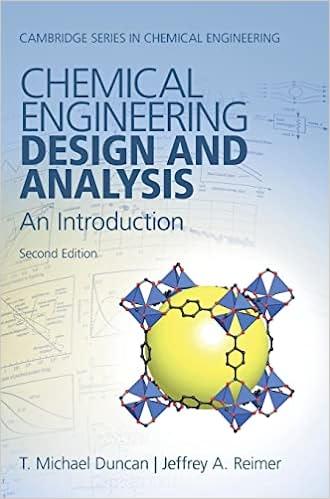Answered step by step
Verified Expert Solution
Question
1 Approved Answer
CHE 5 0 8 Project 0 3 / 2 7 / 2 0 2 4 v 1 Ethanol is an important industrial chemical used as
CHE Project
v
Ethanol is an important industrial chemical used as a solvent, fuel additive, and in the production of beverages. One common method of producing ethanol is through fermentation, which yields a mixture of ethanol and water. However, to be commercially viable, the ethanol must be separated from water to reach the desired concentration. Distillation is a widely used method for separating ethanol from water due to their different boiling points. In fuel applications, ethanol purity of wt or higher is often required to meet regulatory standards for blending with gasoline. However, as ethanol and water will form an azeotrope at high ethanol concentration, a simple distillation process is impossible to achieve the separation. Extractive distillation or a combination with membrane separation is commonly used to achieve the desirable purity of of ethanol. This project focuses on the design of a distillation column for ethanolwater separation and includes a technoeconomic analysis to assess its feasibility and profitability.
Project Objectives:
Design a distillation column for the separation of ethanol and water.
Optimize the column design for costeffectiveness.
Perform a technoeconomic analysis to evaluate the feasibility and profitability of the separation process.
Present findings and recommendations based on the analysis.
More specifically, ethanol will be bought as the raw materials and of ethanol will be sold as product to downstream processing factory. You do not need to work on the membrane part. The distillation column will have ethanol recovered from the top. Assume tonsyear of of ethanol will be produced. The price of the ethanol is purchased at a price of $ ton, and the ethanol is sold at $ ton the product price fluctuation on economic viability should also be considered at the end Maximum of students per project and the contribution of each student has to clearly stated or points will be deducted for all students. You need to finish following tasks for the project.
Use CMO assumption, manually find the number of stages and optimum feed location:
Find the minimum reflux ratio and use that to choose your reflux ratio.
Find the number of stages and optimum feed location with the McCabeThiele method.
Determine the column efficiency and find real column stage number and feed location.
Process Simulation:
Use process simulation software eg Aspen Plus, CHEMCAD to model the distillation process for ethanolwater separation.
Input relevant parameters such as feed composition, temperature, pressure, and desired product specifications.
Find the column design parameters with different reflux ratios reasonably scattered
Validate the simulation results through comparisons with the manually calculated results or literature values.
Distillation Column Design:
Based on the simulation results, design the distillation column including provide detailed calculation steps in the report, only use one reflux ratio as example to explain the calculation, but need to provide Excel file of calculation for all reflux ratios:
Determining column height and diameter.
Selecting appropriate trays or packing materials.
Sizing condensers and reboilers.
Technoeconomic Analysis:
Gather data on capital costs equipment installation operating costs utilities labor and revenue ethanol sales
Perform sensitivity analysis to assess the impact of key parameters eg reflux ratios and price of product fluctuation on economic viability.
Report and Presentation:

Step by Step Solution
There are 3 Steps involved in it
Step: 1

Get Instant Access to Expert-Tailored Solutions
See step-by-step solutions with expert insights and AI powered tools for academic success
Step: 2

Step: 3

Ace Your Homework with AI
Get the answers you need in no time with our AI-driven, step-by-step assistance
Get Started


